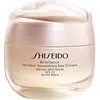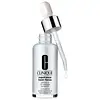What's inside
What's inside
 Key Ingredients
Key Ingredients

 Benefits
Benefits

 Concerns
Concerns

 Ingredients Side-by-side
Ingredients Side-by-side

Water
Skin ConditioningGlycerin
HumectantDipropylene Glycol
HumectantButylene Glycol
HumectantBehenyl Alcohol
EmollientSd Alcohol 40-B
AstringentSilica
AbrasiveDimethicone
EmollientIsododecane
EmollientIsohexadecane
EmollientSorbitol
HumectantBeheneth-20
EmulsifyingMyristyl Myristate
EmollientPhytosteryl Macadamiate
Skin ConditioningErythritol
HumectantXanthan Gum
EmulsifyingTocopheryl Acetate
AntioxidantPEG/PPG-14/7 Dimethyl Ether
Skin ConditioningPEG/PPG-17/4 Dimethyl Ether
Skin ConditioningCaffeine
Skin ConditioningSapindus Mukorossi Peel Extract
Skin ConditioningAngelica Keiskei Leaf/Stem Extract
Skin ConditioningCamellia Sinensis Leaf Extract
AntimicrobialCitrus Junos Seed Extract
AntioxidantZiziphus Jujuba Fruit Extract
Skin ConditioningEucheuma Serra/Grateloupia Sparsa/Saccharina Angustata/Ulva Linza/Undaria Pinnatifida Extract
EmollientCurcuma Longa Rhizome Extract
Skin ConditioningPolyquaternium-51
Skin ConditioningSaccharina Angustata/Undaria Pinnatifida Extract
EmollientChlorella Vulgaris Extract
Skin ConditioningPPG-17
Skin ConditioningStearyl Alcohol
EmollientBeheneth-30
CleansingAlcohol
AntimicrobialCarbomer
Emulsion StabilisingCellulose Gum
Emulsion StabilisingTrisodium EDTA
Hdi/Trimethylol Hexyllactone Crosspolymer
Sodium Citrate
BufferingBHT
AntioxidantSodium Metaphosphate
BufferingPotassium Hydroxide
BufferingCitric Acid
BufferingTocopherol
AntioxidantPPG-3 Dipivalate
Skin ConditioningSodium Metabisulfite
AntioxidantPhenoxyethanol
PreservativeParfum
MaskingIron Oxides
Water, Glycerin, Dipropylene Glycol, Butylene Glycol, Behenyl Alcohol, Sd Alcohol 40-B, Silica, Dimethicone, Isododecane, Isohexadecane, Sorbitol, Beheneth-20, Myristyl Myristate, Phytosteryl Macadamiate, Erythritol, Xanthan Gum, Tocopheryl Acetate, PEG/PPG-14/7 Dimethyl Ether, PEG/PPG-17/4 Dimethyl Ether, Caffeine, Sapindus Mukorossi Peel Extract, Angelica Keiskei Leaf/Stem Extract, Camellia Sinensis Leaf Extract, Citrus Junos Seed Extract, Ziziphus Jujuba Fruit Extract, Eucheuma Serra/Grateloupia Sparsa/Saccharina Angustata/Ulva Linza/Undaria Pinnatifida Extract, Curcuma Longa Rhizome Extract, Polyquaternium-51, Saccharina Angustata/Undaria Pinnatifida Extract, Chlorella Vulgaris Extract, PPG-17, Stearyl Alcohol, Beheneth-30, Alcohol, Carbomer, Cellulose Gum, Trisodium EDTA, Hdi/Trimethylol Hexyllactone Crosspolymer, Sodium Citrate, BHT, Sodium Metaphosphate, Potassium Hydroxide, Citric Acid, Tocopherol, PPG-3 Dipivalate, Sodium Metabisulfite, Phenoxyethanol, Parfum, Iron Oxides
Water
Skin ConditioningDimethicone
EmollientButylene Glycol
HumectantMethyl Trimethicone
Skin ConditioningVinyl Dimethicone/Methicone Silsesquioxane Crosspolymer
Polysorbate 20
EmulsifyingBis-PEG-18 Methyl Ether Dimethyl Silane
EmollientGlycerin
HumectantSilica
AbrasivePolymethylsilsesquioxane
Lauryl PEG-9 Polydimethylsiloxyethyl Dimethicone
Skin ConditioningMethyl Gluceth-20
HumectantPolysilicone-11
Sigesbeckia Orientalis Extract
Skin ConditioningSalvia Sclarea Extract
AntiseborrhoeicAcetyl Glucosamine
Skin ConditioningPlankton Extract
Skin ConditioningLactis Proteinum
Skin ConditioningSea Whip Extract
Skin ConditioningArabidopsis Thaliana Extract
AntioxidantCaffeine
Skin ConditioningAcetyl Hexapeptide-8
HumectantGlycine Soja Protein
EmulsifyingSodium Hyaluronate
HumectantMicrococcus Lysate
Skin ConditioningPalmitoyl Oligopeptide
CleansingErgothioneine
AntioxidantAminopropyl Ascorbyl Phosphate
AntioxidantCaprylyl Glycol
EmollientEthylhexylglycerin
Skin ConditioningTocopheryl Acetate
AntioxidantCholesterol
EmollientGlyceryl Polymethacrylate
Sodium Hydroxide
BufferingLecithin
EmollientCarbomer
Emulsion StabilisingPEG-8
HumectantXanthan Gum
EmulsifyingCitric Acid
BufferingDisodium EDTA
Phenoxyethanol
PreservativeWater, Dimethicone, Butylene Glycol, Methyl Trimethicone, Vinyl Dimethicone/Methicone Silsesquioxane Crosspolymer, Polysorbate 20, Bis-PEG-18 Methyl Ether Dimethyl Silane, Glycerin, Silica, Polymethylsilsesquioxane, Lauryl PEG-9 Polydimethylsiloxyethyl Dimethicone, Methyl Gluceth-20, Polysilicone-11, Sigesbeckia Orientalis Extract, Salvia Sclarea Extract, Acetyl Glucosamine, Plankton Extract, Lactis Proteinum, Sea Whip Extract, Arabidopsis Thaliana Extract, Caffeine, Acetyl Hexapeptide-8, Glycine Soja Protein, Sodium Hyaluronate, Micrococcus Lysate, Palmitoyl Oligopeptide, Ergothioneine, Aminopropyl Ascorbyl Phosphate, Caprylyl Glycol, Ethylhexylglycerin, Tocopheryl Acetate, Cholesterol, Glyceryl Polymethacrylate, Sodium Hydroxide, Lecithin, Carbomer, PEG-8, Xanthan Gum, Citric Acid, Disodium EDTA, Phenoxyethanol
Ingredients Explained
These ingredients are found in both products.
Ingredients higher up in an ingredient list are typically present in a larger amount.
Butylene Glycol (or BG) is used within cosmetic products for a few different reasons:
Overall, Butylene Glycol is a safe and well-rounded ingredient that works well with other ingredients.
Though this ingredient works well with most skin types, some people with sensitive skin may experience a reaction such as allergic rashes, closed comedones, or itchiness.
Learn more about Butylene GlycolCaffeine is most associated with coffee, tea, and cacao. In skincare, it helps with calming inflammation and is rich in antioxidants.
While caffeine is used to treat cellulite and and dark circles, further studies are needed to prove this. It has been believed to help with these skin conditions due to its ability to dilate blood vessels and increase blood flow.
Some studies are looking into caffeine's ability to protect against UV rays.
Learn more about CaffeineCarbomer is a polymer of acrylic acid. Its main role is to create a gel consistency.
A high amount of carbomer can cause pilling or balling up of products. Don't worry, most products contain 1% or less of carbomer.
Citric Acid is an alpha hydroxy acid (AHA) naturally found in citrus fruits like oranges, lemons, and limes.
Like other AHAs, citric acid can exfoliate skin by breaking down the bonds that hold dead skin cells together. This helps reveal smoother and brighter skin underneath.
However, this exfoliating effect only happens at high concentrations (20%) which can be hard to find in cosmetic products.
Due to this, citric acid is usually included in small amounts as a pH adjuster. This helps keep products slightly more acidic and compatible with skin's natural pH.
In skincare formulas, citric acid can:
While it can provide some skin benefits, research shows lactic acid and glycolic acid are generally more effective and less irritating exfoliants.
Most citric acid used in skincare today is made by fermenting sugars (usually from molasses). This synthetic version is identical to the natural citrus form but easier to stabilize and use in formulations.
Read more about some other popular AHA's here:
Learn more about Citric AcidDimethicone is a type of synthetic silicone created from natural materials such as quartz.
What it does:
Dimethicone comes in different viscosities:
Depending on the viscosity, dimethicone has different properties.
Ingredients lists don't always show which type is used, so we recommend reaching out to the brand if you have questions about the viscosity.
This ingredient is unlikely to cause irritation because it does not get absorbed into skin. However, people with silicone allergies should be careful about using this ingredient.
Note: Dimethicone may contribute to pilling. This is because it is not oil or water soluble, so pilling may occur when layered with products. When mixed with heavy oils in a formula, the outcome is also quite greasy.
Learn more about DimethiconeGlycerin is already naturally found in your skin. It helps moisturize and protect your skin.
A study from 2016 found glycerin to be more effective as a humectant than AHAs and hyaluronic acid.
As a humectant, it helps the skin stay hydrated by pulling moisture to your skin. The low molecular weight of glycerin allows it to pull moisture into the deeper layers of your skin.
Hydrated skin improves your skin barrier; Your skin barrier helps protect against irritants and bacteria.
Glycerin has also been found to have antimicrobial and antiviral properties. Due to these properties, glycerin is often used in wound and burn treatments.
In cosmetics, glycerin is usually derived from plants such as soybean or palm. However, it can also be sourced from animals, such as tallow or animal fat.
This ingredient is organic, colorless, odorless, and non-toxic.
Glycerin is the name for this ingredient in American English. British English uses Glycerol/Glycerine.
Learn more about GlycerinPhenoxyethanol is a preservative that has germicide, antimicrobial, and aromatic properties. Studies show that phenoxyethanol can prevent microbial growth. By itself, it has a scent that is similar to that of a rose.
It's often used in formulations along with Caprylyl Glycol to preserve the shelf life of products.
Silica, also known as silicon dioxide, is a naturally occurring mineral. It is used as a fine, spherical, and porous powder in cosmetics.
Though it has exfoliant properties, the function of silica varies depending on the product.
The unique structure of silica enhances the spreadability and adds smoothness, making it a great texture enhancer.
It is also used as an active carrier, emulsifier, and mattifier due to its ability to absorb excess oil.
In some products, tiny microneedles called spicules are made from silica or hydrolyzed sponge. When you rub them in, they lightly polish away dead skin layers and enhance the penetration of active ingredients.
Learn more about SilicaTocopheryl Acetate is AKA Vitamin E. It is an antioxidant and protects your skin from free radicals. Free radicals damage the skin by breaking down collagen.
One study found using Tocopheryl Acetate with Vitamin C decreased the number of sunburned cells.
Tocopheryl Acetate is commonly found in both skincare and dietary supplements.
Learn more about Tocopheryl AcetateWater. It's the most common cosmetic ingredient of all. You'll usually see it at the top of ingredient lists, meaning that it makes up the largest part of the product.
So why is it so popular? Water most often acts as a solvent - this means that it helps dissolve other ingredients into the formulation.
You'll also recognize water as that liquid we all need to stay alive. If you see this, drink a glass of water. Stay hydrated!
Learn more about WaterXanthan gum is used as a stabilizer and thickener within cosmetic products. It helps give products a sticky, thick feeling - preventing them from being too runny.
On the technical side of things, xanthan gum is a polysaccharide - a combination consisting of multiple sugar molecules bonded together.
Xanthan gum is a pretty common and great ingredient. It is a natural, non-toxic, non-irritating ingredient that is also commonly used in food products.
Learn more about Xanthan Gum